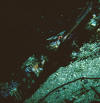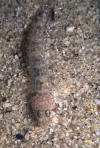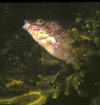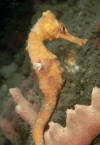|
Shore fish face many dangers. When the tide is out they may
be preyed upon by birds. When the tide comes back in they are at risk of being
smashed against the rocks or washed away from the shore. These fish exhibit a
number of characteristics to cope with this way of life. Many are small and
slippery enabling them to hide in crevices away from predators and the direct
force of the waves, while others are cleverly camouflaged against the seaweed
and rocks where they live. Some fish, such as the shore clingfish, are able to
cope with the battering of the waves by developing powerful suckers. The eggs of
shore fish are also at risk from predation and being washed into unsuitable
habitats or into deeper water. Therefore, shore fish, unlike open sea fish,
often take great care of their eggs. Nests are built and eggs are protected and
aerated.
 Worm Pipefish and Greater Pipefish
Nerophis lumbriformis (Jenyns) and Syngnathus acus (Linnaeus) Worm Pipefish and Greater Pipefish
Nerophis lumbriformis (Jenyns) and Syngnathus acus (Linnaeus)
Pipefish are related to seahorses and like
seahorses the male pipefish are remarkable in the extent to which they care for
their young. After courtship the male entwines his body around the female and
she passes her eggs into a special pouch in his belly. In the pouch the eggs
develop and hatch. The young of the greater pipefish leave the pouch a few weeks
after hatching, but, for the first few days, they will return to the safety of
the males pouch if danger threatens. The young of the worm pipefish are
relatively undeveloped when they are released into the water and spend several
weeks developing in the plankton.
Pipefish feed on small shrimps and fish larvae. They do not have teeth and break
up their prey by the force of sucking their food up their long snouts.
The worm pipefish is particularly well camouflaged in seaweed. Its stem-like
body can change colour depending on the colour of the seaweed in which it lives
while it moves in a gentle swaying motion like seaweed being washed side to side
in the tide.
The worm pipefish is most frequently found on the south and west coasts of
Britain. Both pipefish, however have become rarer since the eel-grass decline,
in the 1930’s.
 Sand goby and Common goby
Pomatoschisus minutus (Pallas) and Pomatoschistus microps
(Kroyer) Sand goby and Common goby
Pomatoschisus minutus (Pallas) and Pomatoschistus microps
(Kroyer)
Gobies are common fish of rock pools. They
can be distinguished from blennies by their dorsal fin, which is
characteristically split into two. The common and sand goby are often seen
darting around in shallow sandy pools. These two gobies are very difficult to
tell apart from their appearance, but they are normally found in different
habitats. The common goby differs from the sand goby in its tolerance of low
salinities and is frequently found in estuaries and high shore rock pools. The
sand goby frequents sandy bays of North Devon and Cornwall, while the common
goby is more abundant in the estuaries on the south coast.
In spring and summer the sand and common goby lay their pear-shaped eggs in
empty bivalve shells. Like most shore fish, the male gobies guard and fan the
eggs until they hatch. The larvae then float mid-water, settling on the seabed
when the fish are about 1.5 cm in length.
Both gobies feed mainly on small shrimps. In the winter, both gobies migrate
into deeper water. Most sand and common gobies only live for a year.
 Shanny or common blenny
Lipophrys pholis (Linnaeus) Shanny or common blenny
Lipophrys pholis (Linnaeus)
The shanny is probably the most common
rock pool fish. The shanny is able to change colour to match its background.
Dark brown individuals are found amongst brown seaweeds whilst olive green fish
are found amongst green seaweeds. When breeding the males darken to almost black
and their lips are a contrasting white. After spawning in spring and summer,
female fish attach their eggs to the underside of rocks or in crevices. The
males watch over the eggs constantly for up to two months, fanning the eggs with
their fins.
Shannies feed mainly on small crabs and other crustaceans but may also eat
seaweed. Young fish sometimes nip off the legs of feeding barnacles. They may
live to ten or more years.
 Rock goby Gobius
paganellus (Linnaeus) Rock goby Gobius
paganellus (Linnaeus)
The rock goby is found only on the western
and southern coasts of Britain where it is abundant on rocky shores.
Eggs are laid in spring and summer on the underside of rocks. Young fish of
about 0.5 cm in length hatch out after two to three weeks. The rock goby may
live for up to ten years.
The goby has a varied diet feeding on shrimps, molluscs, young fish and seaweed.
The weak sucker formed by the pelvic fins of the rock goby, and other gobies, is
unlikely to provide much resistance from the force of wave action but it may
help the goby to maintain its position.
 Corkwing wrasse
Crenilabrus melops (Linnaeus Corkwing wrasse
Crenilabrus melops (Linnaeus
In spring, the brightly coloured male corkwing wrasse may
be seen building an elaborate nest from seaweed. The male aggressively guards
his nest, chasing off other fish. Mature females, however, are enticed into his
nest to lay eggs. Interestingly, counterfeit males, that look like females, have
also been observed. These impostors trick the nest-building male into allowing
them into his nest, where instead of laying eggs they fertilise eggs recently
laid by females. The nest-owner takes great care of the eggs in his nest. He
covers the eggs with seaweed and aerates them by using his tail as a fan. After
hatching the larvae float freely in the plankton, drifting back inshore in late
summer to settle on the seabed. It is believed corkwings may live up to nine
years.
Corkwing feed mainly on small crustaceans, worms and molluscs. They have also
been observed to pick parasites of other fish.
 Ballan wrasse Labrus
bergylta (Ascanius Ballan wrasse Labrus
bergylta (Ascanius
The ballan wrasse has a very peculiar
life-history. In summer, eggs are laid in nests built of fine seaweed. After a few weeks small
larval fish hatch out and are dispersed in the currents before finally settling
in shallow water. The fish then take at least six years before they are mature.
All these fish are female. Several seasons later some of these females change
sex and become males.
The young of the ballan wrasse are frequently found in rock pools. Their green
colouration provides good camouflage amongst the rock pool seaweeds.
The wrasse feed on mussels and on crustaceans, including crabs and barnacles.
For this purpose they have crushing teeth in their throats in addition to their
normal teeth. The lower set of throat teeth are in the form of a cross and these
teeth used to be carried by fishermen as a charm against drowning.
 Tompot blenny
Parablennius gattorugine (Linnaeus) Tompot blenny
Parablennius gattorugine (Linnaeus)
The tompot blenny is a very inquisitive fish. It often
comes out of its hole and props itself up on two spines on its pelvic fins in
order to have a better view of any activities. If threatened it may retreat back
into its hole but it will very shortly reappear again, with its curiosity
getting the better of it. In the spring, the female will lay her eggs in rocky
crevices. However, as is common with many shore fish, it is the male that will
look after the eggs, fanning them with his tail and guarding them.
The fish is found on the west and south coast of Britain but is most abundant
around the south-west coast. The name ‘tompot’ originated in Cornwall, where
children gave them this nickname after frequently finding them caught in crab
pots.
The tompot blenny appears to feed mainly on small shrimps and crabs
 Long-Spined sea scorpion
Taurulus bubalis (Euphrasen) Long-Spined sea scorpion
Taurulus bubalis (Euphrasen)
This fish is an expert at camouflage. Amongst green algae
the fish is bright green; amongst brown algae it is olive-brown, while on the
red rocks of the South Devon coast brick-red animals have been found.
In early spring, the sea scorpion lays orange-coloured eggs amongst seaweed. It
is not known whether the parents look after the eggs. However, after about six
or seven weeks the eggs hatch and the larvae float mid-water to develop further
before settling on the seabed.
Sea scorpions are voracious predators feeding on gobies, blennies, sand-hoppers,
shrimps, prawns and crabs. They lie in wait amongst weeds and leap out on
unsuspecting prey.
Despite their name and spiny appearance sea scorpions are not poisonous
 Shore clingfish or Cornish sucker
Lepadogaster lepadogaster (Bonnaterre) Shore clingfish or Cornish sucker
Lepadogaster lepadogaster (Bonnaterre)
Shore clingfish are only found on the south and south-west coasts of Britain
but are also found off the west coast of France and in the Mediterranean. In the
summer sheets of yellow eggs are laid under stones by the fish. These eggs are
guarded by one of the adults. Gradually the eggs turn from yellow to olive
green. Larvae hatch out after about two weeks and are dispersed in the water.
The strong sucker formed from the pelvic fins prevents the small fish from being
washed away in the tide. This fish is able to turn from a pale to a dark colour
and vise versa to match its background.
 Giant goby Gobius
cobitus Giant goby Gobius
cobitus
This rare species is only found in the Isles of Scilly and
along the south coasts of Devon and Cornwall, although, it is common in the
Mediterranean. The fish was first reported in Britain in 1903 in rock pools at
Portscatho between Falmouth and Fowey. The relatively high shore pools in which
it is found are often quite bare except for green seaweed growths. The pools are
normally quite brackish. The giant goby is the largest goby found in Europe. It
feeds on green algae, sand hoppers and shore crabs.
 Sea Horse Hippocampus hudsonius
Sea Horse Hippocampus hudsonius
Sea Horse, any of a number of small fishes of the same family as the pipefish.
The name is derived from the resemblance of the head to that of a horse. It has
long, tubular jaws much like a snout. The body is compressed, with an elongated
tail, and the integument (external covering) is a series of large, rectangular
bony plates, with a series of spines and projections along the lines of juncture.
These spines, together with the divided, streamerlike fins of some species, give
them a strong resemblance to the seaweeds among which they live. About 30
species are found in various warm and temperate seas. All keep near the shore,
often developing in brackish water. Like the pipefishes, the males take charge
of the eggs, which are placed in an abdominal pouch and remain there until they
hatch. The common sea horse of the Atlantic coast is one of the largest species,
reaching a length of more than 13 cm (more than 5 in).
|